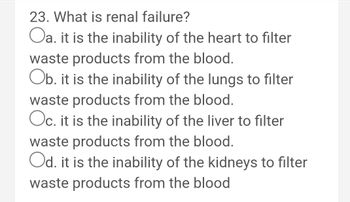
Phlebotomy Essentials
6th Edition
ISBN: 9781451194524
Author: Ruth McCall, Cathee M. Tankersley MT(ASCP)
Publisher: JONES+BARTLETT PUBLISHERS, INC.
expand_more
expand_more
format_list_bulleted
Question
thumb_up100%

Transcribed Image Text:23. What is renal failure?
Oa. it is the inability of the heart to filter
waste products from the blood.
Ob. it is the inability of the lungs to filter
waste products from the blood.
Oc. it is the inability of the liver to filter
waste products from the blood.
Od. it is the inability of the kidneys to filter
waste products from the blood
Expert Solution
This question has been solved!
Explore an expertly crafted, step-by-step solution for a thorough understanding of key concepts.
Step by stepSolved in 3 steps

Knowledge Booster
Similar questions
- 29) There are many negative consequences for a diet high in sodium. Explain how too much sodium in the diet would affect function of the kidneys and the composition of the urine. What tubules of the kidney would be most affected? Provide 2 examples from non-human species for removal of sodium. (short answer please)arrow_forward81. A 54-year-old man comes to the physician for a routine health maintenance examination. His pulse is 80/min, respirations are 14/min, and blood pressure is 140/95 mm Hg. Physical examination shows no other abnormalities. Treatment with an angiotensin I-converting enzyme inhibitor is most likely to cause which of the following sets of renal hemodynamic changes in this patient? 000000000 COMO 992 E) Glomerular Capillary Pressure No change No change No change Renal Blood Flow t no change no change no changearrow_forward2. Kidney stones are formed in the nephron and cause problems for urine exiting the kidney. One has exited the nephron and is blocking urine from leaving the kidney. Where is it located? Renal cortex Renal medulla Renal pelvis Glomerulus 3. A child has severe diarrhea for a few days and becomes dehydrated. Which is the most likely outcome? Oliguria Anuria Polyuriaarrow_forward
- 3. Draw a kidney tubule cell. Be sure to label the apical and basolateral membrane. Label where the inside of the nephron tubule is located. In your drawing, add in all of the important channels and pumps for glucose reabsorption.arrow_forwarde The excretory system regulates the volume and composition of body fluids by removing wastes and returning useful substances to the body. Some of the characteristics of the excretory organs are given below. 1. Carries urine to the bladder 2. Stores urine 3. Eliminates urine from the body 4. Composed of nephrons Put the numbers of the above characteristics in order, so they correspond to the urinary bladder, the ureters, the kidneys, and the urethra. (Your answer should look like 1234, but that isn't the right order.) Answer: Next page OFarrow_forward3. Which structures is not found within, or as part of the renal corpuscle? A. These structures are all found within the renal corpusle B. Glomerulus C. Podocytes D. Renal Capsule E. Afferent and Efferent Arterioles This is not and will not be gradedarrow_forward
- 1. What are the three functions of the nephron? o Where within the nephron do each of the above functions occur? Be sure to indicate if any of these functions occur only, or to a higher degree, within a specific region of the nephron.arrow_forward40. What is the proper sequence of structures in the nephron? Group of answer choices proximal convoluted tubule, glomerulus, loop of Henle, distal convoluted tubule glomerulus, proximal convoluted tubule, loop of Henle, distal convoluted tubule glomerulus, loop of Henle, proximal convoluted tubule, distal convoluted tubule glomerulus, proximal convoluted tubule, distal convoluted tubule, loop of Henlearrow_forwardA patient takes a medication that as a side effect leads to partial inhibition of diuresis. How will this affect the blood pressure of the patient? The patient's blood pressure will decrease. The patient's blood pressure will increase. The patient's blood pressure won't be affected. The patient's blood pressure will decrease but only momentarily.arrow_forward
arrow_back_ios
arrow_forward_ios
Recommended textbooks for you
 Phlebotomy EssentialsNursingISBN:9781451194524Author:Ruth McCall, Cathee M. Tankersley MT(ASCP)Publisher:JONES+BARTLETT PUBLISHERS, INC.
Phlebotomy EssentialsNursingISBN:9781451194524Author:Ruth McCall, Cathee M. Tankersley MT(ASCP)Publisher:JONES+BARTLETT PUBLISHERS, INC. Gould's Pathophysiology for the Health Profession...NursingISBN:9780323414425Author:Robert J Hubert BSPublisher:Saunders
Gould's Pathophysiology for the Health Profession...NursingISBN:9780323414425Author:Robert J Hubert BSPublisher:Saunders Fundamentals Of NursingNursingISBN:9781496362179Author:Taylor, Carol (carol R.), LYNN, Pamela (pamela Barbara), Bartlett, Jennifer L.Publisher:Wolters Kluwer,
Fundamentals Of NursingNursingISBN:9781496362179Author:Taylor, Carol (carol R.), LYNN, Pamela (pamela Barbara), Bartlett, Jennifer L.Publisher:Wolters Kluwer, Fundamentals of Nursing, 9eNursingISBN:9780323327404Author:Patricia A. Potter RN MSN PhD FAAN, Anne Griffin Perry RN EdD FAAN, Patricia Stockert RN BSN MS PhD, Amy Hall RN BSN MS PhD CNEPublisher:Elsevier Science
Fundamentals of Nursing, 9eNursingISBN:9780323327404Author:Patricia A. Potter RN MSN PhD FAAN, Anne Griffin Perry RN EdD FAAN, Patricia Stockert RN BSN MS PhD, Amy Hall RN BSN MS PhD CNEPublisher:Elsevier Science Study Guide for Gould's Pathophysiology for the H...NursingISBN:9780323414142Author:Hubert BS, Robert J; VanMeter PhD, Karin C.Publisher:Saunders
Study Guide for Gould's Pathophysiology for the H...NursingISBN:9780323414142Author:Hubert BS, Robert J; VanMeter PhD, Karin C.Publisher:Saunders Issues and Ethics in the Helping Professions (Min...NursingISBN:9781337406291Author:Gerald Corey, Marianne Schneider Corey, Cindy CoreyPublisher:Cengage Learning
Issues and Ethics in the Helping Professions (Min...NursingISBN:9781337406291Author:Gerald Corey, Marianne Schneider Corey, Cindy CoreyPublisher:Cengage Learning

Phlebotomy Essentials
Nursing
ISBN:9781451194524
Author:Ruth McCall, Cathee M. Tankersley MT(ASCP)
Publisher:JONES+BARTLETT PUBLISHERS, INC.

Gould's Pathophysiology for the Health Profession...
Nursing
ISBN:9780323414425
Author:Robert J Hubert BS
Publisher:Saunders

Fundamentals Of Nursing
Nursing
ISBN:9781496362179
Author:Taylor, Carol (carol R.), LYNN, Pamela (pamela Barbara), Bartlett, Jennifer L.
Publisher:Wolters Kluwer,

Fundamentals of Nursing, 9e
Nursing
ISBN:9780323327404
Author:Patricia A. Potter RN MSN PhD FAAN, Anne Griffin Perry RN EdD FAAN, Patricia Stockert RN BSN MS PhD, Amy Hall RN BSN MS PhD CNE
Publisher:Elsevier Science

Study Guide for Gould's Pathophysiology for the H...
Nursing
ISBN:9780323414142
Author:Hubert BS, Robert J; VanMeter PhD, Karin C.
Publisher:Saunders

Issues and Ethics in the Helping Professions (Min...
Nursing
ISBN:9781337406291
Author:Gerald Corey, Marianne Schneider Corey, Cindy Corey
Publisher:Cengage Learning